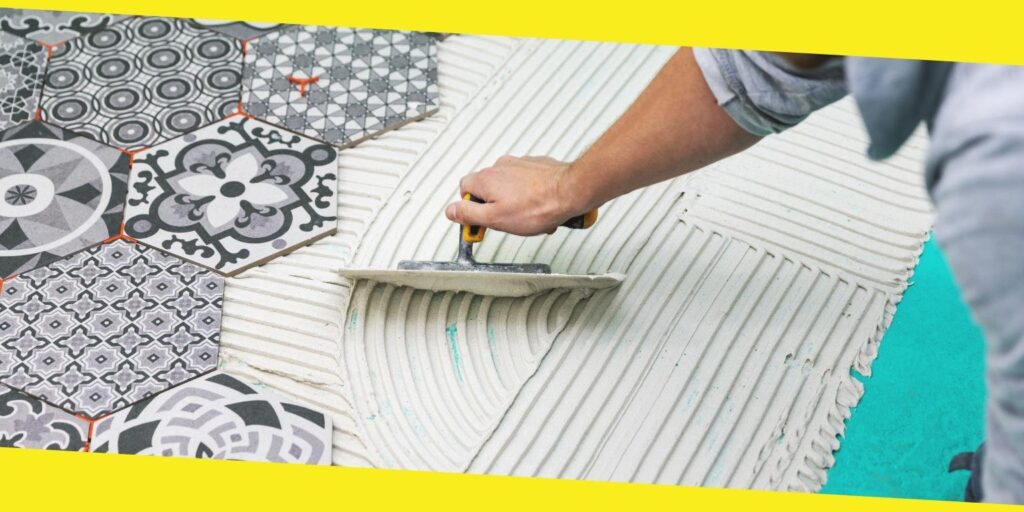What Is the Difference Between Tile Adhesive and Tile Mortar?
This post was last updated on July 7th, 2023

There are two types of tile adhesives – thin set and epoxy. Thinset is the cheapest and is commonly used in industrial settings. Epoxy requires specialized training, and it is not recommended for residential areas. Due to its strong odor, it is best used by professionals. On the other hand, most residential settings use thin set mortar, which is made up of powder.
While mortar is considered the most common type of adhesive, thin set mortar is used to seal spaces between tiles. The latter fills gaps between the tiles, while the former covers up the areas between them. The type of adhesive you use will depend on the type of tile and the installation location. Some types are waterproof, while others are not. Make sure to read product instructions carefully.
The most common type of tile adhesive is epoxy. It is a resin-based compound that binds to the tile’s surface, and it is waterproof, chemical- and grease-resistant.
The most common type of tile adhesive is epoxy. It is a resin-based compound that binds to the surface of the tile. It is waterproof, chemical- and grease-resistant. However, it is much more expensive than other types, tricky to use. Most professionals recommend leaving this job to professionals. If you aren’t sure which one to use, it may be best to call in a professional.
Thinset mortar is a mixture of cement and lime and is the recommended choice for large applications.
Thinset mortar is a mixture of cement and lime and is the recommended choice for large applications. It is used with heavy, thick tiles, and a thin bed is a medium-size layer of mortar. The thickness of the thick-set mortar is equal to the thickness of the tiles. When comparing the two types of tile adhesive, you can see how each has its pros and cons.
A tile adhesive is an acrylic compound that bonds tiles to the surface.
A tile adhesive is an acrylic compound that bonds tiles to the surface. The latter is made to hold tiles firmly. Both types have different purposes. A general-purpose type of adhesive is best for small wall tiles, while a strong one is best for large-format ceramic tile. A grout will create a smooth, seamless look. A thin-set, however, is not suitable for wall-tile installations. Check the manufacturer’s website to learn more about it!
A thin set is more durable than mastic.
It is ideal for horizontal applications. But it is often easier to apply than a tile adhesive. The difference between grout and mastic depends on the type of application. A tile adhesive is a mixture of cement and fine sand, and a grout is a glue that bonds the tiles together. A thin set is a liquid that is used in a wet room.
A Thickset is a type of thin set mortar that bonds tiles.
A Thickset is a type of thin set mortar that bonds tiles. A thick-set mortar is used in a bathroom. But it is also possible to mix a thin set and a grout. These two materials share some of the same ingredients, but they aren’t the same. Using adhesive instead of grout is recommended when the adhesive isn’t needed. You can mix both products to make sure you get the best results.
A tile adhesive is a polymer-modified cement-based tile adhesive.
A tile adhesive is a polymer-modified cement-based tile adhesive. It can be used on floor and wall tiles. But it would help if you did not use it on marble or stone because it can cause water damage to the substrate. A thin set mortar is the best choice for large-scale jobs and prevents the tile from slipping. If the tiles are a different color, you can buy grout instead of tiles.
Both are cement-based adhesives, and both are intended for tile installations.
A thin set mortar resembles tile adhesive but has the same function. Both are cement-based adhesives, and both are intended for tile installations. The differences between these two types of adhesives are often subtle. And they should be considered carefully before purchasing any mortar. It is essential to use the right one for your application, and it is because it will affect the look of the final product.
Recommended For You
Things to Know Before Buying Bank Auction Property
Most Inside
Most Inside offers high-quality recommendations and valuable updates to enhance all aspects of your life, providing premium guidance and enriching experiences.


![The Importance of Driveway Alarms for Home Security [8 Advantages] The Importance of Driveway Alarms for Home Security [8 Advantages]](https://www.mostinside.com/wp-content/uploads/2023/07/driveway-alarms-for-home-125x125.jpg)

